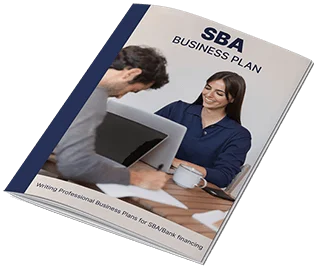How To Write SBA Business Plan With Free Template
Table of Contents
- SBA Business Plan Template
- SBA - what is it? and what is the purpose of the SBA business plan?
- What is SBA?
- Purpose of SBA Business Plan?
- Looking for a business plan writing service provider?
- What are the main components of a SBA business plan?
- How to write each section of a SBA business plan with an example?
- 1. Exective Summary
- 2. Company Description
- 3. Market Analysis
- 4. Organization and Management
- 5. Product or Services Description
- 6. Marketing and Sales
- 7. Funding Request
- 8. Financial Projections
- How To Format And Present Your SBA Business Plan?
- Other SBA Business Plan Templates That Can Help You Prove a Loan With Your SBA Business Plan
A business plan is a vital document for any entrepreneur who wants to start or grow a small business. It outlines your vision, goals, strategies, market analysis, financial projections, and more. It helps you to organize your thoughts, identify potential challenges and opportunities, and communicate your vision to others. A well-written business plan can also help you secure funding from the Small Business Administration (SBA), which offers loans and grants to eligible small businesses. The SBA has specific requirements and standards for business plans, and you need to follow them carefully if you want to increase your chances of getting approved.
In this blog post, we will guide you through the steps of writing a SBA business plan with an example. We will cover the following topics:
SBA Business Plan Template
Creating a business plan that meets the standards of the Small Business Administration (SBA) can be challenging, but not with our SBA Business Plan Template. This template is based on the best practices and guidelines of the SBA, and it will walk you through the key sections of a business plan, such as the executive summary, market analysis, competitive advantage, financial projections, and more. You can easily adapt the template to your specific industry, niche, and goals, and save yourself time and hassle in the process. Our SBA Business Plan Template is not just a document – it’s a tool that will help you secure funding, attract customers, and grow your business successfully. We have years of experience in helping small businesses achieve their dreams, and we are confident that our template will help you too.
SBA - what is it? and what is the purpose of the SBA business plan?
What is SBA?
SBA stands for Small Business Administration. It is an independent agency of the United States government that provides support to entrepreneurs and small businesses. The SBA is a valuable resource for small businesses. If you are starting or running a small business, the SBA can help you get the financing, counseling, and training you need to succeed.
The SBA offers a variety of programs and services, including:
Loans: The SBA guarantees loans made by banks and other lenders to small businesses. This can help small businesses get the financing they need to start or grow their business.
Surety Bonds: The SBA provides surety bonds to small businesses that need them to bid on government contracts. This can help small businesses compete for government contracts that they might not otherwise be able to get.
Consulting: The SBA offers counseling and training to small businesses on a variety of topics, such as business planning, marketing, and financial management.
Government Contracting: The SBA helps small businesses get government contracts. The SBA has a set-aside program that reserves a certain percentage of government contracts for small businesses.
Advocacy: The SBA advocates on behalf of small businesses in Washington, D.C. The SBA works to ensure that small businesses have a voice in the federal government.
Here are some of the benefits of SBA loans:
Low interest rates: SBA loans typically have lower interest rates than conventional loans. This can save you money on your monthly payments.
Longer repayment terms: SBA loans typically have longer repayment terms than conventional loans. This can give you more time to pay back your loan.
Guarantee: The SBA guarantees 75% of SBA loans. This means that the lender is only at risk for 25% of the loan amount. This makes it easier for small businesses to get approved for loans.
Learn how to write a business plan for loan in just 7 simple steps
Purpose of SBA Business Plan?
The purpose of an SBA business plan is to provide a roadmap for your business. It should outline your goals, strategies, and financial projections. The SBA business plan is a requirement for many SBA loans, but it can also be a valuable tool for any small business owner. If you are thinking about starting or running a small business, an SBA business plan is a valuable tool. It can help you to secure funding, guide your business, attract investors, improve your management skills, and track your progress.
Here are some of the specific purposes of an SBA business plan:
- To secure funding: The SBA business plan is a key document that lenders will review when considering your loan application. It will help them to understand your business and its potential for success.
- To guide your business: The SBA business plan can help you to stay focused on your goals and make informed decisions about your business. It can also help you to identify potential problems and develop solutions.
- To attract investors: If you are looking to attract investors, an SBA business plan can be a valuable tool. It will help you to communicate your vision for your business and convince investors that your business is a good investment.
- To improve your management skills: The process of writing an SBA business plan can help you to improve your management skills. It will force you to think critically about your business and develop a plan for its success.
- To track your progress: The SBA business plan can be used to track your progress and make adjustments as needed. It can also help you to identify areas where your business is doing well and areas where it needs improvement.

Looking for a business plan writing service provider?
Get the best business plan service now!
What are the main components of a SBA business plan?
The main components of an SBA business plan are:
- Executive summary: This is a brief overview of your business, including its products or services, target market, and competitive advantages.
- Company description: This section provides more detailed information about your business, such as its history, legal structure, and management team.
- Products and services: This section describes the products or services that your business offers.
- Market analysis: This section analyzes your target market, including its size, growth potential, and competitive landscape.
- Marketing plan: This section outlines your strategies for reaching and acquiring customers.
- Operations plan: This section describes how your business will be run on a day-to-day basis.
- Management team: This section introduces your management team and their qualifications.
- Financial projections: This section provides estimates of your business’s revenue, expenses, and cash flow.
- Appendix: This section includes supporting documents, such as financial statements, marketing materials, and product samples.
The SBA does not have a set format for business plans, so you can tailor your plan to the specific requirements of the lender you are applying to. However, the SBA does recommend that all business plans include the following elements:
- A clear and concise overview of your business
- A realistic assessment of your market and competition
- A well-defined marketing plan
- A sound financial plan
- A strong management team
If you are applying for an SBA loan, it is important to carefully prepare your business plan. The SBA will review your plan carefully to assess the viability of your business and your chances of success.
Here are some additional tips for writing an SBA business plan:
- Be clear and concise. The SBA reviewers are busy people, so they don’t have time to read through long, rambling business plans.
- Be realistic. Don’t make unrealistic projections about your revenue or growth.
- Be specific. Don’t just say that you’re going to “market your product.” Explain exactly how you’re going to do it.
- Be persuasive. The goal of your business plan is to convince the SBA to lend you money. So make sure your plan is well-written and persuasive.
Access our 14 free sample business plans now!
How to write each section of a SBA business plan with an example?
A business plan is a document that describes your business idea, goals, strategies, and operations. It helps you communicate your vision to potential investors, lenders, partners, and customers. It also helps you plan and manage your business effectively.
The U.S. Small Business Administration (SBA) provides a standard business plan template that you can use to write your own plan. The template consists of eight major sections that cover the essential aspects of your business. Here is a brief overview of each section and an example of how to write it.
1. Exective Summary
This section summarizes the main points of your business plan in one or two pages. It should capture the reader’s attention and interest, and highlight your unique value proposition, target market, competitive advantage, financial projections, and funding needs. You should write this section last, after completing the rest of your plan.
Example:
XYZ Inc. is a software company that develops and sells cloud-based solutions for small and medium-sized businesses (SMBs). Our products help SMBs manage their accounting, invoicing, payroll, inventory, and customer relationship management (CRM) processes more efficiently and securely.
We have a proven track record of delivering high-quality software solutions to over 1,000 customers across various industries. We have a strong team of experienced developers, marketers, and customer support specialists who are passionate about solving our customers’ problems and providing them with exceptional service.
We are seeking $500,000 in debt financing from the SBA to expand our product portfolio, increase our marketing efforts, and hire more staff. We expect to generate $2 million in revenue and $500,000 in net income in the first year of operation, and grow at an annual rate of 25% for the next five years.
2. Company Description
This section provides detailed information about your company’s history, mission, vision, values, goals, objectives, legal structure, ownership, location, and facilities. It should also describe the problems your business solves, the customers you serve, and the competitive advantages that make your business stand out.
Example:
XYZ Inc. was founded in 2019 by John Smith and Jane Doe, two software engineers who saw a gap in the market for affordable and easy-to-use cloud-based solutions for SMBs. They started developing their first product, XYZ Accounting, in their garage, and launched it in 2020 after securing their first customer.
Our mission is to empower SMBs with innovative and reliable software solutions that help them streamline their business processes and grow their revenue. Our vision is to become the leading provider of cloud-based solutions for SMBs in the U.S. and beyond. Our values are excellence, innovation, customer satisfaction, integrity, and teamwork.
We are a Delaware corporation with 10% ownership by John Smith, 10% ownership by Jane Doe, and 80% ownership by XYZ Holdings LLC, a holding company owned by John Smith and Jane Doe. We operate from our headquarters in San Francisco, California, where we have a 5,000 square foot office space that accommodates our development, marketing,
and customer support teams.
How to write each section of a SBA business plan with an example?
3. Market Analysis
This section analyzes the industry, market, and competition for your business. It should provide data and evidence to support your market opportunity, customer needs, demand, trends, growth potential, and competitive landscape. It should also explain how you plan to enter, position, and differentiate your business in the market.
Example:
The cloud-based software market for SMBs is expected to grow at a compound annual growth rate (CAGR) of 15% from 2020 to 2025, reaching $50 billion in revenue by 2025, according to a report by Market Research Inc. The main drivers of this growth are the increasing adoption of cloud computing, the need for cost-effective and scalable solutions, and the demand for remote work and collaboration tools.
Our target market is SMBs in the U.S. that have between 10 and 500 employees and operate in various industries such as retail, manufacturing, healthcare, education, and professional services. We estimate that there are over 5 million SMBs in the U.S. that fit this criteria, and that they spend an average of $10,000 per year on software solutions.
Our main competitors are ABC Inc., DEF Inc., and GHI Inc., which offer similar cloud-based solutions for SMBs. However, we have several competitive advantages that set us apart from them:
– We offer a more comprehensive and integrated suite of products that cover all the essential business functions of SMBs.
– We offer a more affordable and flexible pricing model that allows SMBs to pay only for what they use and scale up or down as needed.
– We offer a more user-friendly and intuitive interface that makes our products easy to learn and use.
– We offer a more personalized and responsive customer service that provides 24/7 support and training.
We plan to enter the market by leveraging our existing customer base, referrals, testimonials, and online reviews. We also plan to position our business as a one-stop shop for SMBs that need cloud-based solutions to run their businesses efficiently and securely. We also plan to differentiate our business by offering superior quality, value, innovation, and customer satisfaction.
4. Organization and Management
This section describes the organizational structure, management team, roles and responsibilities, qualifications, and compensation of your business. It should also include any advisors, consultants, board members, or key employees that are involved in your business. It should demonstrate how your team has the skills, experience, and expertise to execute your business plan successfully.
Example:
XYZ Inc. has a simple and flat organizational structure that consists of three main departments: development, marketing, and customer support. Each department is led by a manager who reports directly to the CEO. The CEO is also the co-founder and majority owner of the business.
Our management team consists of:
– John Smith: CEO and co-founder. John has over 10 years of experience in software development and management. He is responsible for overseeing the overall strategy, vision, and direction of the business.
– Jane Doe: CTO and co-founder. Jane has over 10 years of experience in software engineering and design. She is responsible for leading the development team and ensuring the quality and functionality of our products.
– Mark Lee: Marketing manager. Mark has over 5 years of experience in digital marketing and sales. He is responsible for leading the marketing team and executing the marketing strategy and campaigns.
– Lisa Kim: Customer support manager. Lisa has over 5 years of experience in customer service and training. She is responsible for leading the customer support team and providing excellent service and support to our customers.
We also have a board of advisors that consists of:
– Bob Jones: A seasoned entrepreneur and investor who has founded and sold several successful software companies.
– Mary Smith: A former SBA loan officer who has extensive knowledge and experience in financing small businesses.
– Tom Lee: A professor of computer science at Stanford University who is an expert in cloud computing and artificial intelligence.
Our key employees consist of:
– 10 software developers who are skilled in various programming languages, frameworks, and tools.
– 5 marketing specialists who are proficient in various digital marketing channels, techniques, and platforms.
– 5 customer support representatives who are trained in various software products, features, and issues. We compensate our employees with competitive salaries, bonuses, stock options, and benefits such as health insurance, retirement plans, and paid leave.
Get funded faster with a professional SBA business plan writer
5. Product or Services Description
This section describes the products or services that your business offers, and how they benefit your customers. It should also explain the features, functions, quality, design, development, production, delivery, installation, maintenance, and support of your products or services. It should also address any intellectual property rights, patents, trademarks, or licenses that your business owns or needs.
Example:
XYZ Inc. offers a suite of cloud-based software solutions for SMBs that help them manage their accounting, invoicing, payroll, inventory, and CRM processes more efficiently and securely. Our products are:
– XYZ Accounting: A software solution that helps SMBs track their income and expenses, create and send invoices, manage their taxes, and generate financial reports.
– XYZ Payroll: A software solution that helps SMBs calculate and pay their employees’ salaries, wages, taxes, and benefits.
– XYZ Inventory: A software solution that helps SMBs monitor and control their inventory levels, costs, and movements.
– XYZ CRM: A software solution that helps SMBs manage their customer relationships, interactions, sales pipeline, and loyalty programs.
Our products have the following benefits for our customers:
– They save time and money by automating and streamlining their business processes.
– They improve accuracy and compliance by reducing errors and risks.
– They enhance security and reliability by protecting their data and ensuring their availability.
– They increase productivity and profitability by optimizing their performance and growth.
Our products have the following features and functions:
– They are cloud-based, which means they can be accessed from any device, anywhere,
and anytime.
– They are integrated, which means they can share data and communicate with each other seamlessly.
– They are customizable, which means they can be tailored to fit the specific needs and preferences of each customer.
– They are scalable, which means they can handle any volume of transactions and users without compromising speed or quality.
Our products have the following quality standards:
– They are developed using the latest technologies and best practices in software engineering
and design.
– They are tested rigorously and regularly to ensure their functionality and compatibility.
– They are updated frequently to incorporate new features and improvements.
Our products have the following development, production, delivery,
Installation, maintenance, and support processes:
– We use an agile methodology to develop our products in short iterations based on customer feedback and market research.
– We use a cloud service provider to host our products on secure servers that have high availability and performance.
– We use a subscription-based model to deliver our products to our customers via the internet.
– We provide online tutorials and manuals to help our customers install and use our products easily.
– We provide 24/7 technical support via phone, email, chat,
and social media to help our customers resolve any issues or questions they may have.
We own the intellectual property rights to our products,
including the source code, design, logo, name,
and domain. We have registered our trademark with the U.S. Patent
and Trademark Office (USPTO) and obtained a patent for our unique algorithm that powers our products. We also have licenses from various third-party providers that we use to enhance our products’ functionality
and security.
Hire Business Plans Writers Now!
6. Marketing and Sales
This section outlines the marketing strategy and sales plan for your business. It should describe how you plan to reach, attract, and retain your target customers, and how you plan to promote, price, distribute, and sell your products or services. It should also include your sales forecasts, goals, and metrics.
Example:
Our marketing strategy is based on four main elements: segmentation, targeting, positioning, and differentiation. We segment our market based on the size, industry, location, and needs of our potential customers. We target SMBs in the U.S. that have between 10 and 500 employees and operate in various industries such as retail, manufacturing, healthcare, education, and professional services.
We position our business as a one-stop shop for SMBs that need cloud-based solutions to run their businesses efficiently and securely. We differentiate our business by offering superior quality, value, innovation, and customer satisfaction. Our marketing mix consists of four main components: product, price, place, and promotion.
Our product is a suite of cloud-based software solutions for SMBs that help them manage their accounting, invoicing, payroll, inventory, and CRM processes more efficiently and securely. Our price is based on a subscription-based model that allows SMBs to pay only for what they use and scale up or down as needed. Our place is online via our website where we showcase our products features, benefits, testimonials, and reviews.
Our promotion consists of various digital marketing channels such as email marketing social media marketing search engine optimization (SEO) search engine marketing (SEM) content marketing influencer marketing referral marketing
Our sales plan consists of three main stages: lead generation lead conversion customer retention We generate leads by using various online platforms such as Google Ads Facebook Ads LinkedIn.
7. Funding Request
This section should describe how much funding you need and how you plan to use it. It should also include information about your current financial situation, such as your cash flow and balance sheet. You should also explain why you need the funding and how it will help your business grow. For example, if you’re looking to expand your product line or hire more staff, you might need additional funding to cover those costs.
Example
We are seeking $500,000 in debt financing from the SBA to expand our product portfolio, increase our marketing efforts, and hire more staff.
8. Financial Projections
- This section should include financial statements such as income statements, balance sheets, and cash flow statements. It should also include a break-even analysis and a description of how you plan to finance your business. You should provide detailed projections for the next three to five years, including revenue, expenses, and profits. For example, if you’re seeking funding from investors or lenders, they will want to see your financial projections to determine the potential return on investment.
Example
We expect to generate $2 million in revenue and $500,000 in net income in the first year of operation, and grow at an annual rate of 25% for the next five years. We will finance our business through a combination of debt financing and equity financing from investors.
How To Format And Present Your SBA Business Plan?
If you are planning to apply for a Small Business Administration (SBA) loan, you will need to prepare a business plan that meets the SBA’s requirements. A business plan is a document that describes your business’s goals, strategies, market, financial projections, and management team. It also shows how you will use the loan funds and how you will repay them.
A well-written business plan can help you convince lenders and investors that your business is viable and worth supporting. However, writing a business plan can be challenging, especially if you are not familiar with the format and content that the SBA expects. Here are some tips on how to format and present your SBA business plan:
– Follow the SBA’s recommended outline. The SBA provides a detailed outline of the sections and sub-sections that your business plan should include. You can find the outline on the SBA website or download a template from various online sources. The outline covers the following topics: executive summary, company description, market analysis, organization and management, service or product line, marketing and sales, funding request, financial projections, and appendix.
– Use clear and concise language. Your business plan should be easy to read and understand by anyone who reviews it. Avoid using jargon, technical terms, or acronyms that may confuse your readers. Use simple sentences and paragraphs, and use bullet points, tables, charts, and graphs to illustrate your points. Use headings and sub-headings to organize your information and make it easy to scan.
– Provide evidence and support for your claims. Your business plan should not be based on assumptions or guesses. You should provide factual data and analysis to back up your statements about your market, competitors, customers, industry trends, financial projections, and so on. You can use primary sources (such as surveys, interviews, or testimonials) or secondary sources (such as reports, articles, or statistics) to support your claims. Make sure to cite your sources properly and include them in the appendix.
– Be realistic and honest. Your business plan should reflect the true state of your business and its potential. Do not exaggerate or overestimate your strengths, opportunities, or prospects. Do not underestimate or ignore your weaknesses, threats, or risks. Be honest about the challenges you face and how you plan to overcome them. Be realistic about the amount of money you need and how you will use it. Do not make promises or guarantees that you cannot keep.
– Proofread and edit your business plan. Before you submit your business plan to the SBA or any other lender or investor, make sure to check it for errors and inconsistencies. Use a spell-checker and a grammar-checker tool to catch any typos or mistakes. Ask someone else to read your business plan and give you feedback. Make sure your business plan is complete, accurate, coherent, and professional.
Recommended: How To Write A Business Plan In Just 7 Simple Steps
Other SBA Business Plan Templates That Can Help You Prove a Loan With Your SBA Business Plan
Lorem ipsum dolor sit amet, consectetur adipiscing elit. Ut elit tellus, luctus nec ullamcorper mattis, pulvinar dapibus leo.
Lorem ipsum dolor sit amet, consectetur adipiscing elit. Ut elit tellus, luctus nec ullamcorper mattis, pulvinar dapibus leo.





![How to Implement Security Measures That Actually Protect Your Business [Step-by-Step Guide]](https://wisebusinessplans.com/wp-content/uploads/2025/06/how-to-implement-security-measures-that-actually-protect-your-business-1024x576.webp)











